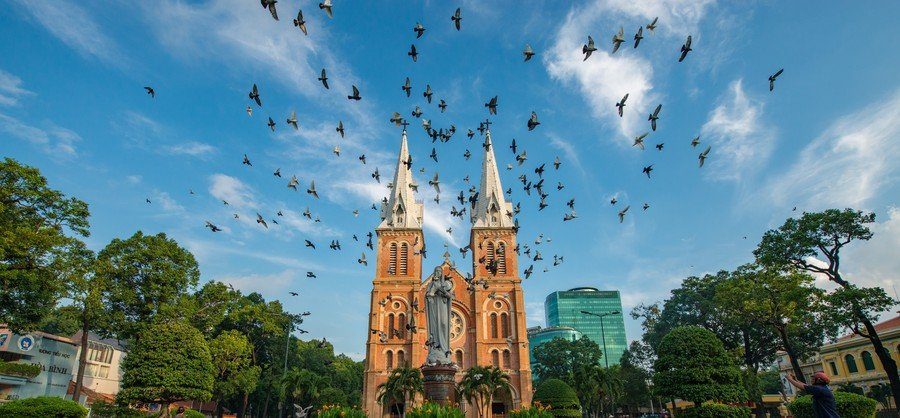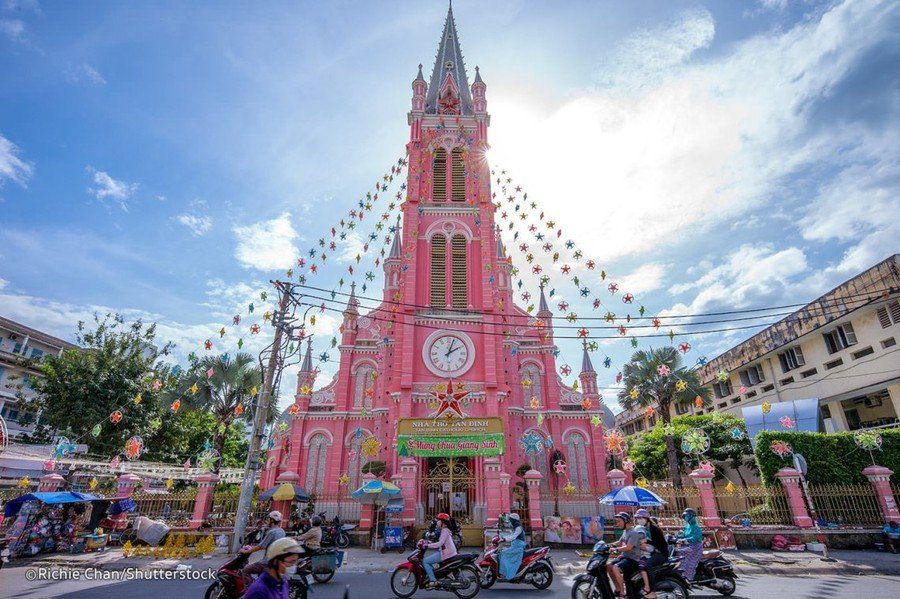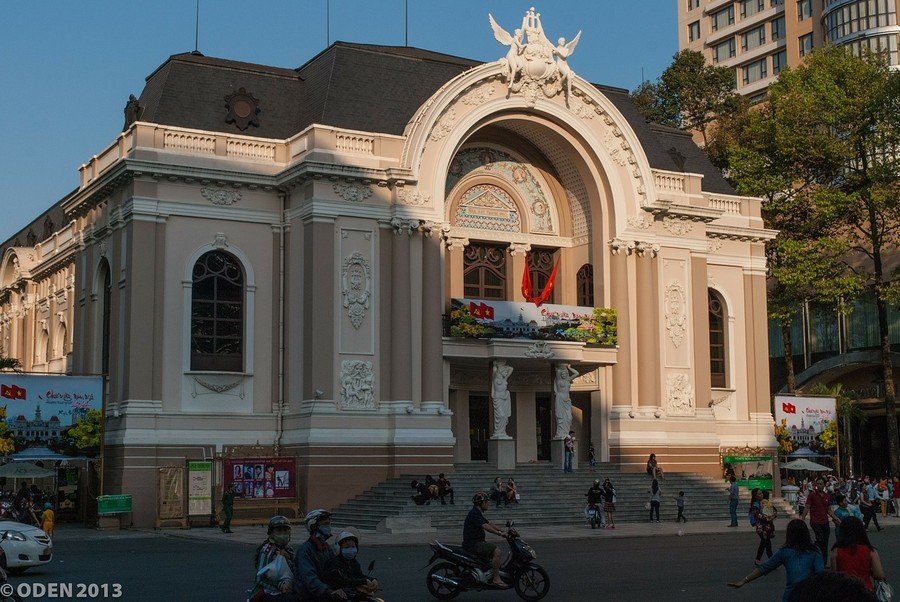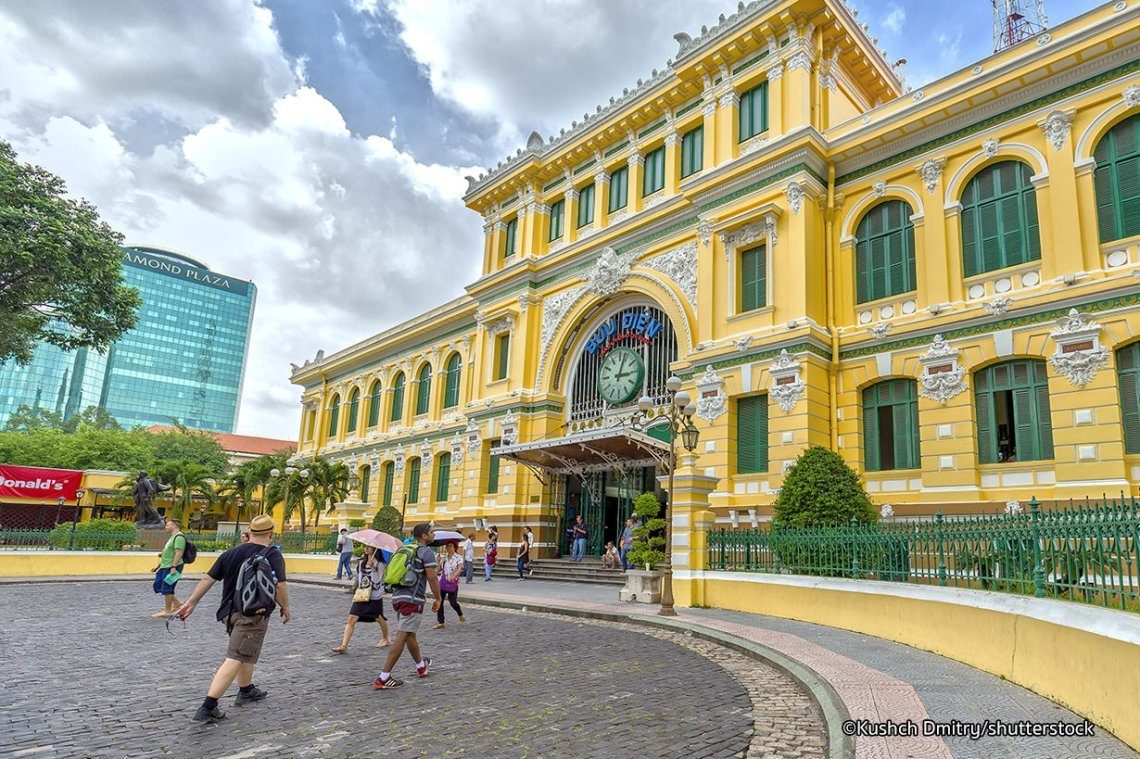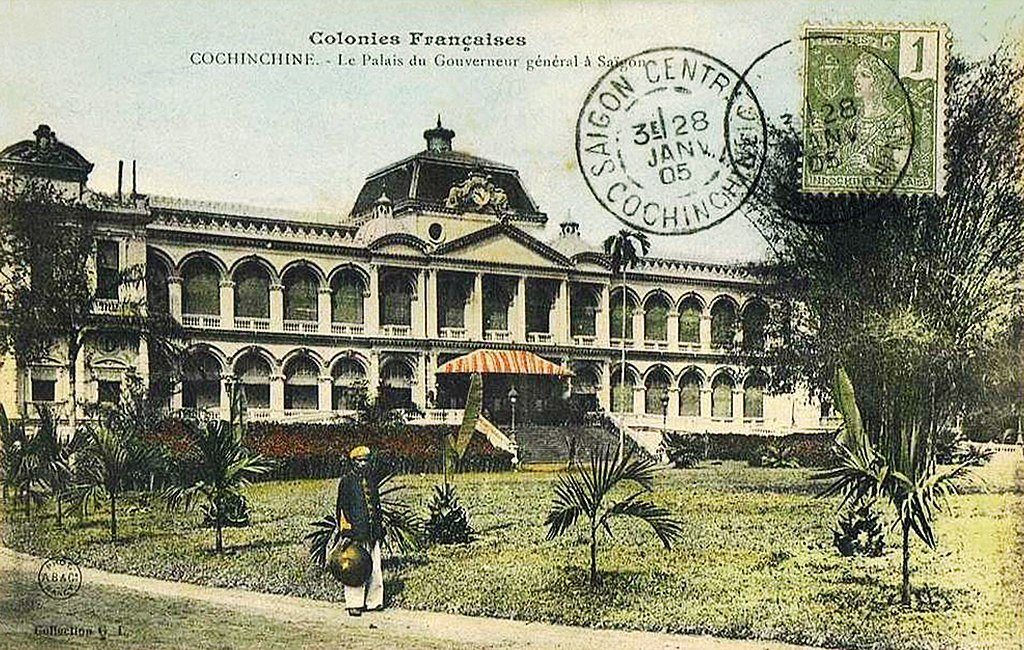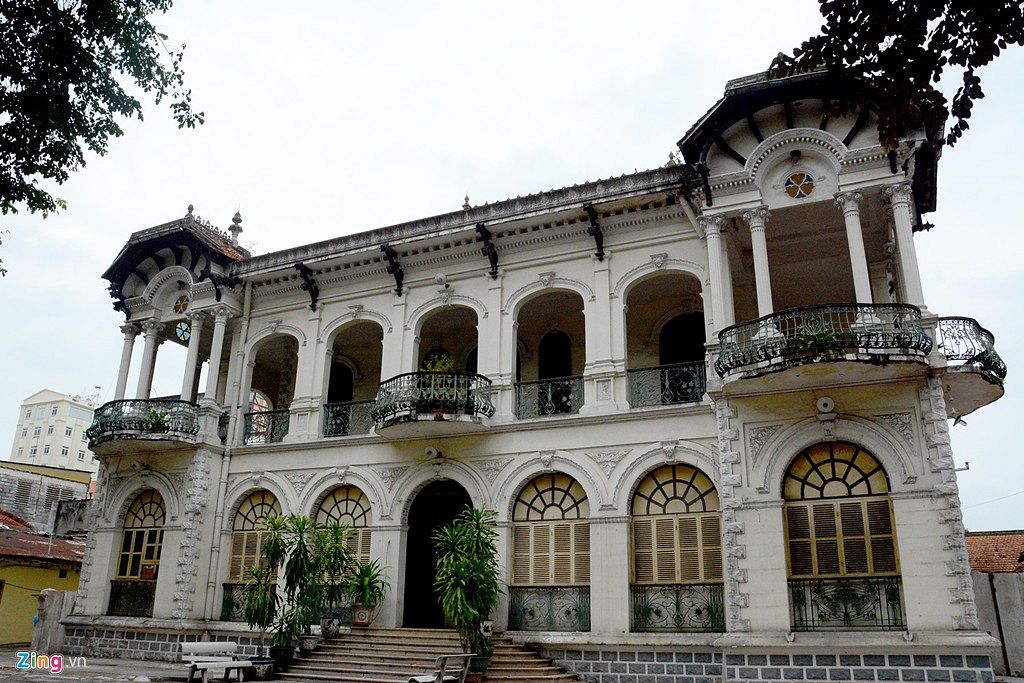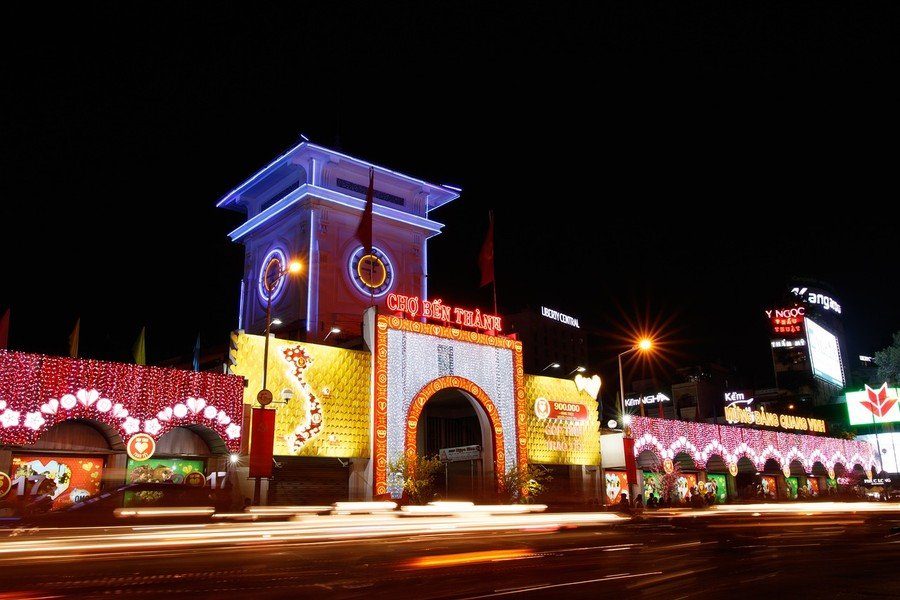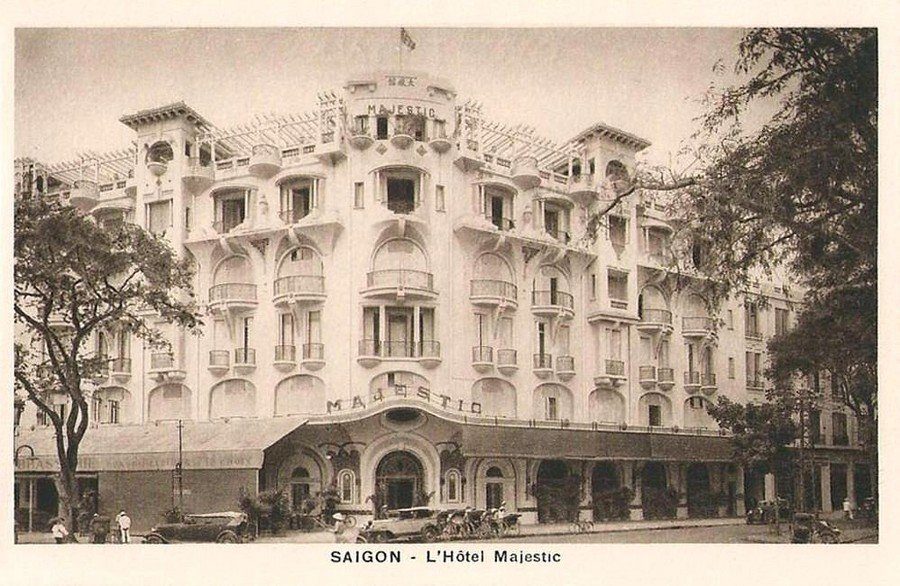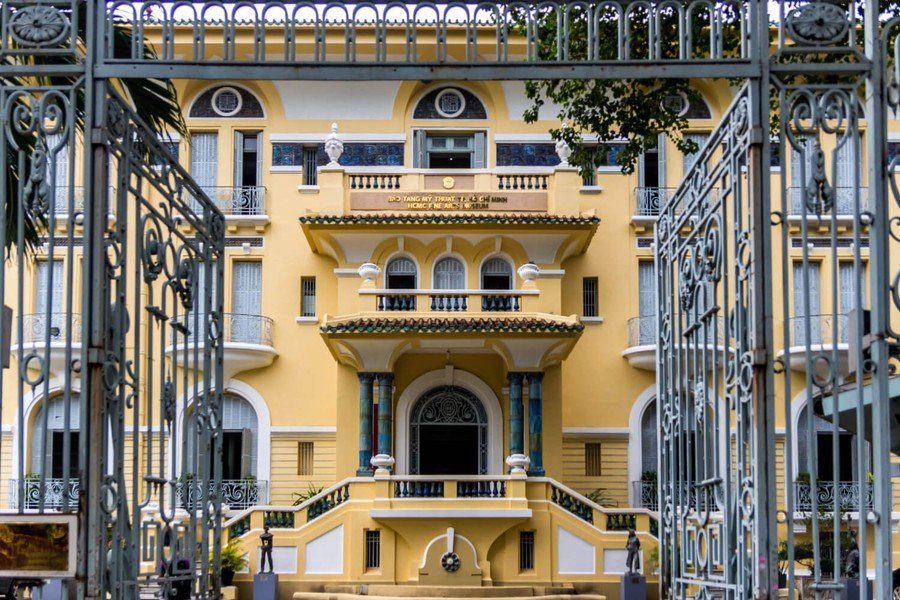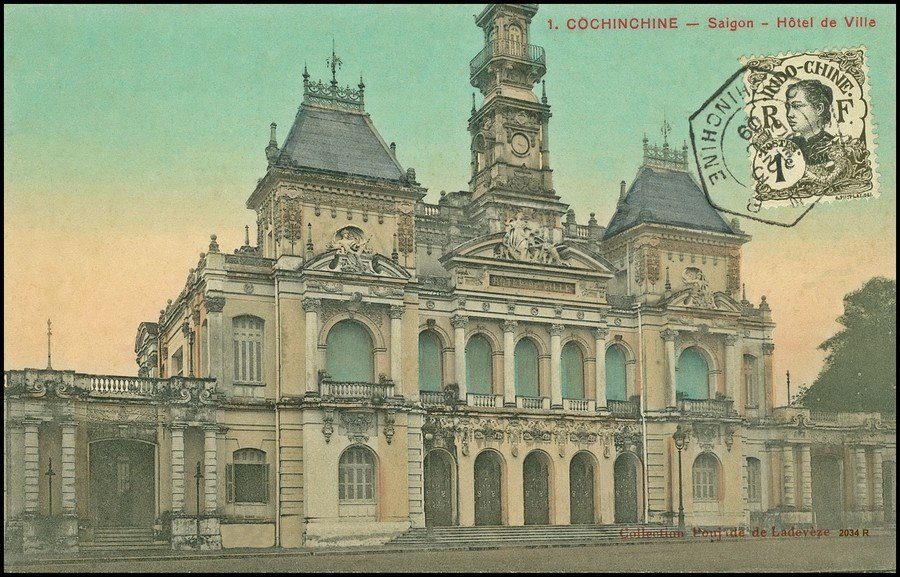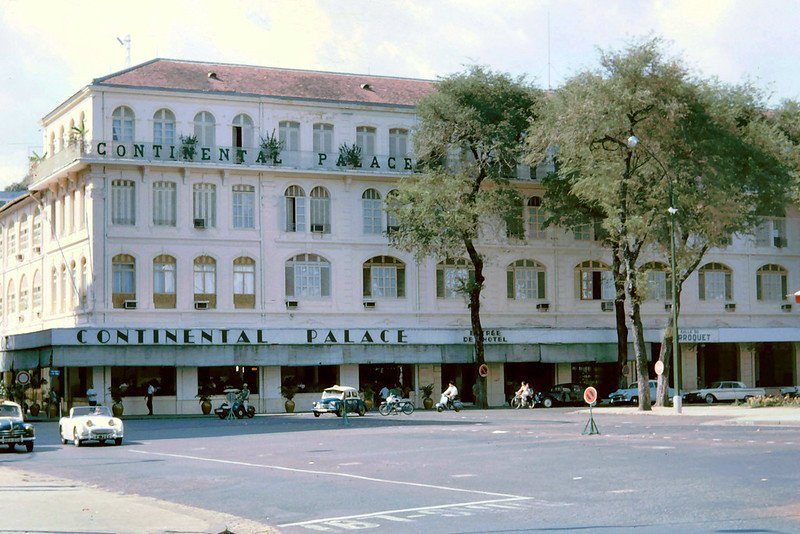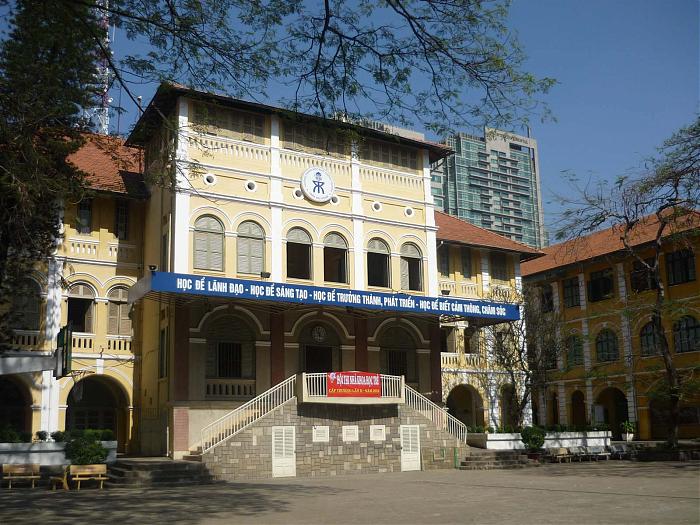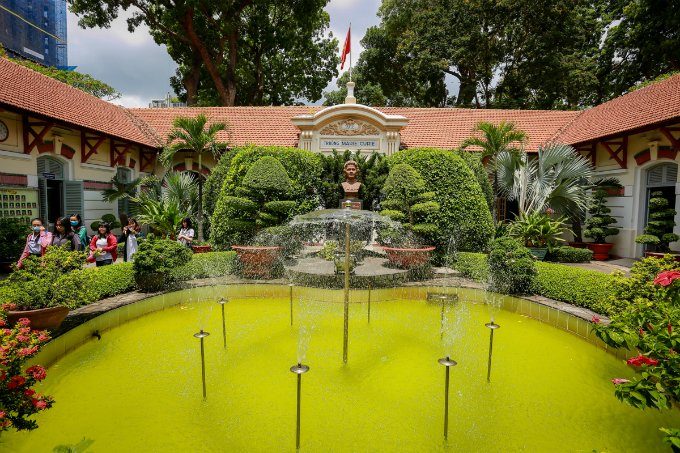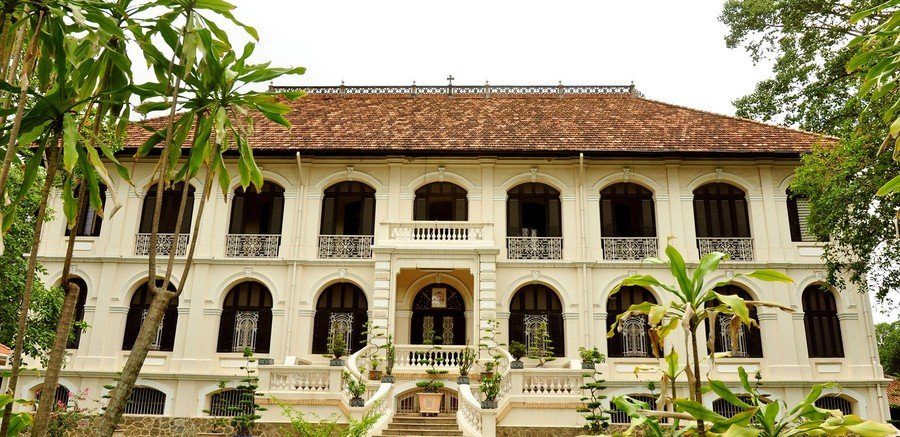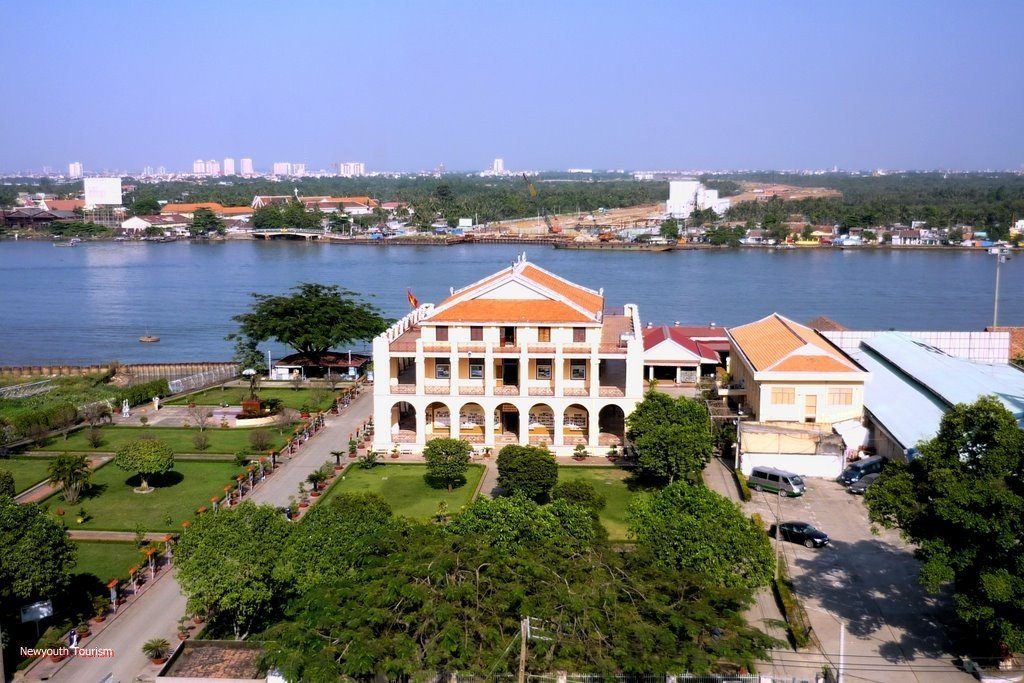With the arrival of the French in the 1860s, the face of the city of Saigon was irretrievably marked by the colonial architecture, with a surprising number of european building for an Asian city
Today, the Atelier offers you a trip back in time to trace the history of the most beautiful French colonial buildings of Ho Chi Minh City. If they are often known to the greatest number, the past of some of them could surprise you!
Table of Contents
ToggleThe Basilica of Our Lady of Saigon
A must-see, Notre-Dame de Saïgon occupies a prominent place in the heart of district 1 of the city.
Built at the request of Bishop Lefebvre between 1863 and 1880 with materials exclusively imported from France (with the exception of his Swedish clock), the building, which mixes neo-Romanesque and Gothic styles, was designed to last. Its architect J. Bourad has provided foundations to withstand 10 times the weight of the building, which measures 135 meters in length and 35 meters in width, and has 56 stained glass windows representing characters and biblical stories.
Its two iconic towers were completed in 1895. As for the statue of the Virgin Mary set back from the entrance, it was imported from Rome in 1959.
With a capacity of 1200 people, the building is currently under renovation, which does not prevent many couples from coming to make their wedding photos.
Adress: 01 Cong Xa Paris, Ben Nghe Ward, District 1
Tan Dinh Church – Pink Church
The church, the second largest in Saigon, is nestled next to the Tan Dinh market in District 3, and is decorated with an exquisite rose.
Of Gothic inspiration and marked by the period of the Renaissance, the church was built in 1876, and like its sister of Notre-Dame, includes two bell towers. The church is famous for the presence of splendid Italian marble altars, installed in 1929.
Adress: 289 Hai Bà Trưng, Phường 8, Quận 3, Hồ Chí Minh
The Refinery
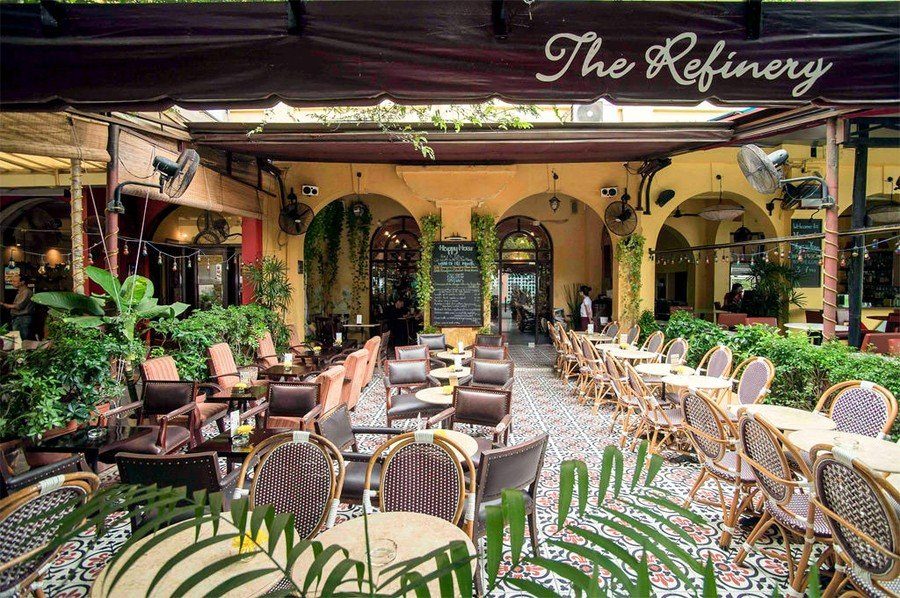
If you live in Saigon, you probably already know the restaurant ” The Refinery”. However, what you may not know is that the name of this restaurant is steeped in history, since the building was originally intended for the treatment of opium!
Like the English, the French of the colonial administration drew an extremely important income from the sale of opium. Since then, the drug that has caused so much havoc has been replaced by traditional gourmet dishes from the French cuisine. It’s the perfect opportunity to taste French specialties in a chic Parisian bistro decor.
Adresse : 74 Hai Bà Trưng, Bến Nghé, Quận 1, Hồ Chí Minh
Saigon Opera
Intended for the entertainment of the high society and French troops stationed in Saigon, the opera, located on Catinat street (today Dong Khoi) was built between 1898 and 1900 with the contribution of no less than three architects: Eugène Ferret, Félix Olivier, and Ernest Guichard. Influenced by the Palais Garnier and more generally by the architectural style that marked the Third Republic, the Opera opened the same year as the Petit Palais in Paris, from which it is also inspired. Its facade is very recognizable with the presence of two caryatids.
Heavily damaged during the Second World War, the building fell into disrepair until 1954. Then, the opera was used to accommodate the North Vietnamese refugees, and was then used as an assembly for the Viet Cong party. The building will not return to its original functions until 1975, and after major renovations, it has a capacity of 800 people.
Today, everyone can go there to see ballets, opera, fashion shows and other cultural events of the first rank.
Adress : 07 Công Trường Lam Sơn, Bến Nghé, Quận 1, Hồ Chí Minh
The Central Post Office
Located on the same square as the Cathedral, the Central Post Office is one of the most beautiful architectural jewels of Saïgon, known to house a metal frame designed by Gustave Eiffel, while its architects were Auguste Henri Vildieu and Alfred Foulhoux.
Comparable to a European train station with its vault whose weight is supported by four columns, the building, built between 1886 and 1891 contains details that will not fail to attract the eye of the most curious.
Outside, you will find the names of historical French characters as well as those of inventors who contributed to the revolutions of electricity and communication, such as Descartes, Morse, Ampere, Volta, Ohm, and Faraday. Also, above the entrance is a clock with the dates of construction and opening of the building.
Inside the post office, you can not miss the huge plan of Saigon and its surroundings, dating from the 1890s, as well as an almost equally huge portrait of Ho Chi Minh. The second notable plan, more recent, dating from 1936, shows the telephone network traversing the South of Vietnam. The 14 telephone booth are priceless legacies of the first calls made in Indochina at the beginning of the XXth century.
Still in operation today, the 38 wickets are open to the public for the post office functions, and you can buy postcards, stamps and souvenirs around them.
Adress : 2 Công xã Paris, Bến Nghé, Quận 1, Hồ Chí Minh
The Norodom Palace
This entry in the list is a bit peculiar, for the good and simple reason that today nothing remains of the original building built by the French, since replaced by the Palace of Reunification.
However, with its 13-hectare gardens and rich history, the Norodom Palace deserves its place in this article. Seat of the Governor of Indochina, the palace was built between 1886 and 1889 in a neo-Baroque style on plans by Achille-Antoine Hermitte, using materials imported from France. Designed to impress, including a 80 meters long facade, its building cost at the time was no less than four million francs, a quarter of the annual budget of the colony, not counting the subsequent work necessary to maintain. His dome was for example replaced in 1893.
With the withdrawal of French troops in 1954, the palace was taken over by Prime Minister Ngo Thoi Nhiem and renamed Independence Palace.
However, in 1962, the palace was damaged by a massive attack by the Saigon Air Force. The damage being considerable, Ngo Dinh Nhiem decided to destroy the whole building to build another one. The current Reunification Palace that we see today is in lieu of the original and was designed by the Vietnamese architect Ngo Viet Thu.
In 1975, the Palace hosted the signing of the Reunification Agreement for South and North Vietnam, ending nearly 30 years of war between Vietnam and the United States, giving it its present name.
The total area of the reunification palace is 4,500 m2, divided into 3 floors, 1 roof, 1 floor, 2 basements and ground for helicopter landings. The building also includes over 100 rooms of different designs and for different uses. Its basements are designed as bunkers.
Adress : 135 Nam Kỳ Khởi Nghĩa, Phường Bến Thành, Quận 1, Hồ Chí Minh
Phuong Nam Mansion
Much less known, the Phuong Nam Manor does not attract as much attention, since the luxurious residence was recently bought for 35 million dollars.
Built between 1915 and 1925 by a rich Vietnamese precious stone merchant, it is one of the largest private buildings in Saigon.
Closed to the public, it is however worth the detour to admire the finesse of its French architecture.
Its colonnaded facade, flanked at each corner by large balconies, features molded balustrades and wrought iron balustrades. The ornamental ridges of the cast iron roof have oriental motifs and the eaves are supported by wooden brackets and decorative lattices. The interior is equally impressive. It features an imposing central staircase with wrought-iron balustrades, elegant crown moldings and cornices, colorful stained glass windows, elaborately carved wooden doors and window frames, and at least four different patterns of colonial floor tiling.
Adress : 110-112 Vo Van Tan, Quận 3, Hồ Chí Minh
Ben Thanh Central Market
First settled along the Ben Nghe River, the Ben Thanh Market pre-dates the arrival of the French. However, having become too old, the decision was taken in 1911 to replace it with Les Halles Centrales.
Completed in 1914 by architects Brossard and Mopin, this Art Deco-style market is surmounted by a vast dome of 28m in diameter, and the main entrance stands out thanks to its large belfry. The market was renovated in 1985.
Its four main doors are all accessible from the street, giving access to its 10,000 daily visitors to a space of over 13,000 m² housing some 1,500 sellers of textiles, shoes, crafts, food and much more.
Adress : Chợ, Lê Lợi, Phường Bến Thành, Quận 1, Hồ Chí Minh
The Majestic Hotel
Built in 1925 by Hui Bon Hoa (with the French architect Rivera), one of the richest men of Saigon at the time, the hotel and its 6 floors and some 175 rooms face the Saigon River.
The main feature of the buildings is its large vaulted roof that covers the sidewalk. Gilding adorns the entire building and individual balconies, while the large, arched windows on the ground floor provide a good view (inside or out) of the grand entrance hall and restaurant.
Adress : 1 Đồng Khởi, Bến Nghé, Quận 1, Hồ Chí Minh
The Museum of Fine Arts
It is again to the businessman Hui Bon Hoa, that one owes the construction of this splendid residence, which was used as a house and office. The most observant visitors will be able to notice near the entrance an iron sign bearing the initials of the initiator of the project (“HBH”).
Designed by the same architect as the Majestic Hotel, this Art Deco building is oriented according to the rules of Feng Shui. Three storeys high, the colonial building stands out for its beautiful interior courtyard.
Since 1975, the place houses the Saigon Museum of Fine Arts and its 20,000 Khmer artifacts, Cham and Indians, paintings and sculptures by Vietnamese artists. Do not miss the café adjoining the museum, housed in a former colonial mansion.
Adresse : 97A Phó Đức Chính, Phường Nguyễn Thái Bình, Quận 1, Hồ Chí Minh
The City Hall
Built between 1898 and 1909, the City Hall is probably Saigon’s most emblematic French building, directly evoking its Parisian counterpart. It combines a Gothic style and Italian influences with the architecture of northern France, built under the direction of architect Fernand Gardès.
In 1975, upon the reunification of Vietnam, the building became the headquarters of the District 1 People’s Committee. Unfortunately, its access is closed to the public.
In front of its facade, find a parterre of lotus and frangipani as well as a statue of Ho Chi Minh recently installed.
At night, the building is superbly lit by an installation sponsored by the city of Lyon. A sight not to be missed after a night walk on Nguyen Hue Street.
Adress : Số 86 Lê Thánh Tôn, Bến Nghé, Quận 1, Hồ Chí Minh
The Continental Hotel
The second hotel on our list, the Continental, was built between 1878 and 1880 by Pierre Cazeau, an industrialist, with the ambition of attracting a prestigious clientele. The hotel will change owner several times, being first bought in 1911 by the Duke of Montpensier, and then in 1930 by Mathieu Francini, a godfather of the Corsican mafia. The hotel will remain in the family until its expropriation in 1975 by the communist government. It will be closed from 1976 to 1986, before being renovated in 1989.
Notable personalities who have stayed at the Continental include the Indian poet and Nobel laureate Rabindranath Tagore, André Malraux, Jacques Chirac, and the novelist Graham Greene.
Throughout its existence, the Continental was a meeting place for many writers, reporters, politicians and entrepreneurs, occupying a central position in Dong Khoi Street, just a few steps away from the opera house. It will be an important venue for the French film “Indochine” and the novel “The Quiet American” by Graham Greene.
Adress : 132-134 Đồng Khởi, Bến Nghé, Quận 1, Hồ Chí Minh
Lasan Taberd
Founded in 1875 by Father Henri De Kerlan, Lasan Taberd was first used to welcome abandoned children.
The school has four blocks, from A to D, two playgrounds, and many trees and a courtyard that can accommodate many activities. The walls painted yellow are mostly kept in their original state.
In 1949, the school had 1200 students. In 1975, it was transferred to the city’s Department of Education.
Entry is now restricted to students, parents and school members. Visitors can hope to visit this other example of French architecture during summer holidays.
Adresse : 53B Nguyễn Du, Bến Nghé, Quận 1
Marie Curie School
Inaugurated in 1918, the Marie Curie private school was originally reserved for elite girls belonging to French families and rich Vietnamese families.
It was not until 1970 that the school began to accept boys. It became a semi-public school in 1997, before being completely public in 2007. With a capacity of 5000 students, it is one of the largest schools in Vietnam, occupying an area of 21,000 m².
Composed of 8 main buildings, the school has many curiosities, such as a fountain and a bust of Marie Curie sitting in the heart of green gardens, and an original reserve of rainwater.
Adresse : 159 Nam Kỳ Khởi Nghĩa, Phường 7, Quận 3, Hồ Chí Minh
The Archbishop Palace
Located in a quiet street of District 3, the impressive building is one of the oldest residences of Saigon, having been built in the late eighteenth century by the one who will become the future Emperor Nguyen Gia Long.
The Palace was originally intended for the French Bishop of Adran, partly in thanks for the French military intervention to help quell a nearby rebellion.
The building is still the home of the archbishop of Saigon.
Adress : 180 Nguyen Dinh Chieu, District 3
Dragon Wharf
Built between 1862 and 1863 on the Saigon River (in what is now District 4), the Dragon Harbor was the first commercial port of the city, connecting Vietnam to the France.
The port is renowned for its unique architecture combining Vietnamese style and French style. This feature is well reflected by the design of a French-style main building, featuring 2 Vietnamese dragon-shaped statues on its roof, a detail that can be often found in the architecture of Vietnam’s traditional temples and pagodas. .
It was from here that Nguyen Tat Thanh, the man who became Ho Chi Minh, left Saigon at the age of 21 for a trip around the world that would last 30 years.
For this reason, the place was reconverted in 1979 into a museum in honor of the independence leader, home to a collection of some of his personal belongings.
Adress : Số 01 Nguyễn Tất Thành, Phường 12, Quận 4, Hồ Chí Minh
You liked this article? Learn more about France and its culture by following l’Atelier An Phu’s French classes for all levels.
Sources :
- Saigon’s Palais Norodom – A Palace Without Purpose
- Old Saigon Building of the Week: Phuong Nam Mansion at 110-112 Vo Van Tan
- French Architecture in Vietnam: 11 Examples that Show French Influence on Vietnamese Architecture
- Discover Saigon’s French Colonial Architecture | Top 10 Sites You Might Not Know
- Traces of time in Saigon’s century-old high school
- [Photos] Lycée Marie Curie: The High School That Has Stood the Test of Time
- Hunting for Colonial Architecture in Saigon

